Mego Page Menu
Action Jackson / American West / Black Hole / Buck Rogers / C.B McHaul / Celebrities & TV Starz / CHIPS / Comic Action Heroes / Doctor Who / Dukes of Hazzard / Flash Gordon / Happy Days / KISS / Laverne & Shirley / Love Boat / Mad Monsters / Moonraker / One Million BC / Our Gang / Planet of the Apes / Pocket Heroes / Robin Hood / Sports Celebrities / Star Trek 1974-1977 / Star Trek 1979-1980 / Starsky & Hutch / Super Knights / Super Pirates / Tex Willer / Waltons / Wizard of Oz / World’s Greatest Super-Heroes

Mego launched their Star Trek action figure line in 1974, and it ran until 1977. The line consisted of three separate waves of 14 total action figures. Playsets of the USS Enterprise and Mission to Gamma VI were also released, along with several fun accessories. The Star Trek line was incredibly successful for Mego, and turned out to be one of their best selling lines of the decade.
For more information about Mego’s Star Trek Original Series products, see bottom of page for a complete summary.
Star Trek (1974-1977): Series 1 Basic Figures
Mego initially released five brand new figures for their first series of Star Trek characters in 1974. Lt. Uhura was added to the Series 1 roster in early 1975. All Series 1 figures were re-released each year that Mego produced Star Trek toys.
Capt. Kirk
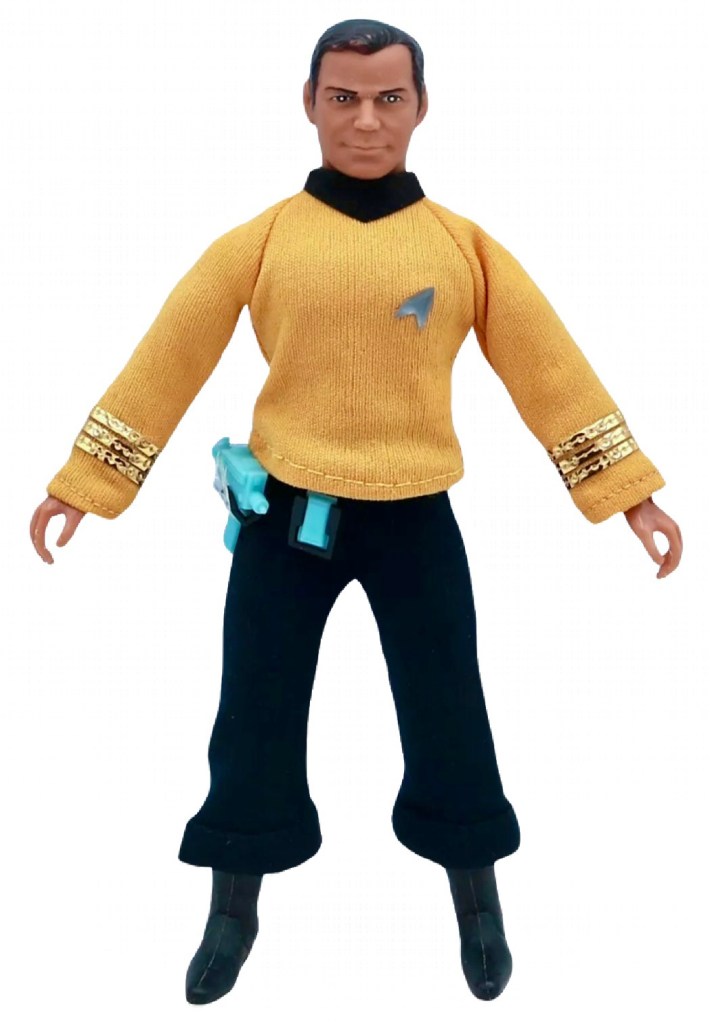

Market Value:
Carded $125 – $175
Loose $25 – $40
Capt. Kirk
Accessories: Cloth Shirt w/ Emblem, Pants, Belt, Phaser, Communicator
Years Released: 1974 – 1977
Difficulty To Find: Common – Easily found on secondary market
Notes: Captain Kirk is a true pop culture icon, famously portrayed by William Shatner in the television show and movies. The action figure of Kirk is a staple that is recognizable by every Mego collector and fan across the world, The head sculpt for the figure is pretty spot-on, as it actually resembles Shatner. Like the other crew members, Kirk’s boots are painted on and not removable. The original issue of Kirk has a card with the original five character portraits on it, and white logo lettering. When Uhura was added to Series 1 in early 1975, the card was changed to match, with the Uhura portrait being added and the Star Trek logo lettering changing to blue.
Dr. McCoy (Bones)


Market Value:
Carded $140 – $190
Loose $30 – $45
Dr. McCoy (Bones)
Accessories: Cloth Shirt w/ Emblem, Pants, Belt, Phaser, Communicator, Tricorder
Years Released: 1974 – 1977
Difficulty To Find: Less Common – Appears less often
Notes: Dr. McCoy or Bones was famously portrayed by Deforest Kelley in the television show and movies. The head sculpt for the figure is pretty spot-on, as it really captures the likeness of Kelley. Like the other crew members, Dr. McCoy’s boots are painted and not removable. The original issue of McCoy has a card with the original five character portraits on it, and white logo lettering. When Uhura was added to Series 1 in early 1975, the card was changed to match, with the Uhura portrait being added and the Star Trek logo lettering changing to blue.
Klingon

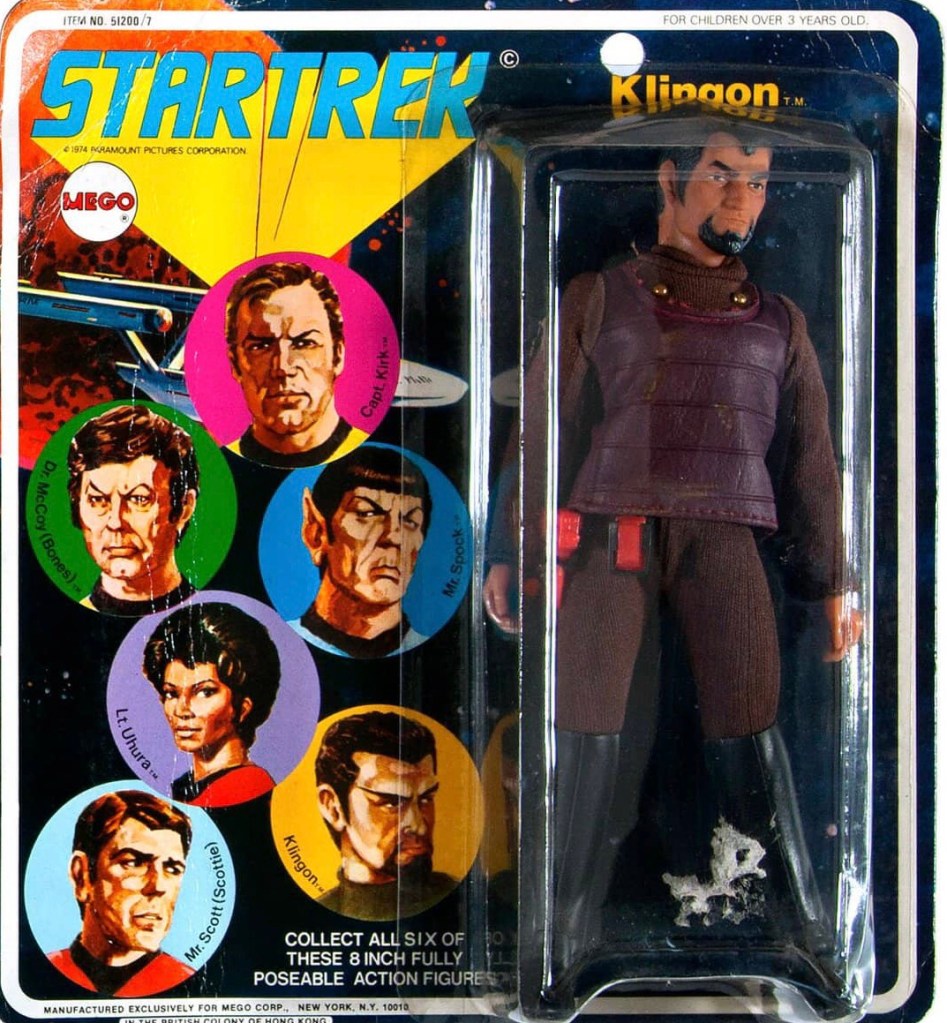
Market Value:
Carded $80 – $110
Loose $22 – $35
Klingon
Accessories: Cloth Tunic, Pants, Boots, Belt, Phaser, Communicator
Years Released: 1974 – 1977
Difficulty To Find: Common – Easily found on secondary market
Notes: The Klingon figure was actually based off the Captain Koloth character from the classic television show. The Klingons, of course, changed their entire appearance for the future movies and beyond. The head sculpt for the figure is quite nice with the outfit also being fairly accurate. Unlike the Enterprise crew members, The Klingon has actual boots instead of being painted on. The original issue of Klingon has the card with the original five character portraits on it, and white logo lettering. When Uhura was added to Series 1 in early 1975, the card was changed to match, with the Uhura portrait being added and the Star Trek logo lettering changing to blue.
Lt. Uhura


Market Value:
Carded $125 – $175
Loose $30 – $45
Lt. Uhura
Accessories: Cloth Dress w/ Emblem, Tights, Boots, Tricorder
Years Released: 1975 – 1976
Difficulty To Find: Less Common – Appears less often
Notes: Lt. Uhura was famously portrayed by Nichelle Nichols in the television show and movies. The head sculpt for the figure is not bad, but nowhere the accuracy of the others. Unlike the crew members, Lt. Uhura has removable boots instead of being painted on. Female characters were not very in demand from the target audience for these figures, so kudos to Mego for even producing Uhura at all. Uhura was not available with the initial release of the first five figures but was added late to the series in late 1974, thus she was never available on the five character portraits card with the white logo lettering.
Mr. Scott (Scottie)


Market Value:
Carded $160 – $240
Loose $40 – $60
Mr. Scott (Scottie)
Accessories: Cloth Shirt w/ Emblem, Pants, Belt, Phaser, Communicator
Years Released: 1974 – 1977
Difficulty To Find: Less Common – Appears less often
Notes: Mr. Scott or Scottie was famously portrayed by James Doohan in the television show and movies. The head sculpt for the figure is pretty good, but it is definitely more like the animated Scottie than the live action show. Like the other crew members, Mr. Scott’s boots are painted on and not removable. The original issue of Mr. Scott has the card with the original five character portraits on it, and white logo lettering. When Uhura was added to Series 1 in early 1975, the card was changed to match, with the Uhura portrait being added and the Star Trek logo lettering changing to blue.
Mr. Spock

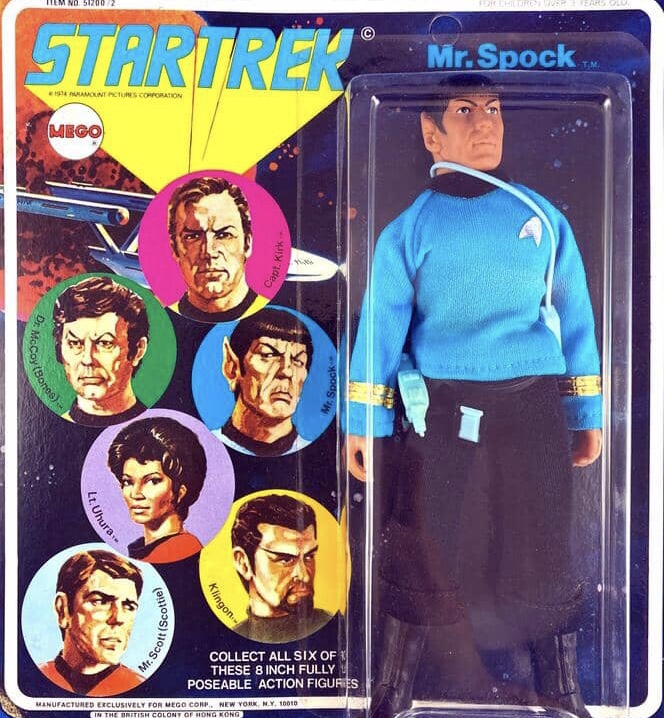
Market Value:
Carded $125 – $175
Loose $30 – $45
Mr. Spock
Accessories: Cloth Shirt w/ Emblem, Pants, Belt, Phaser, Communicator, Tricorder
Years Released: 1974 – 1977
Difficulty To Find: Common – Easily found on secondary market
Notes: Mr. Spock is a true pop culture icon, famously portrayed by Leonard Nimoy in the television show and movies. The action figure of Spock is a staple that every Mego collector in the world should most definitely own. Like the others in this series, the head sculpt is pretty spot-on, as it really does resemble Nimoy. Like the other crew members, Spock’s boots are painted on and not removable. The original issue of Spock has the card with the original five character portraits on it, and white logo lettering. When Uhura was added to Series 1 in early 1975, the card was changed to match, with the Uhura portrait being added and the Star Trek logo lettering changing to blue.
Star Trek (1975): Series 2 Aliens Figures
After massive success with the first series of Star Trek figure, a 2nd series was released the following year in 1975, that contained four more new figures. All figures were Aliens from the classic television show.
Cheron

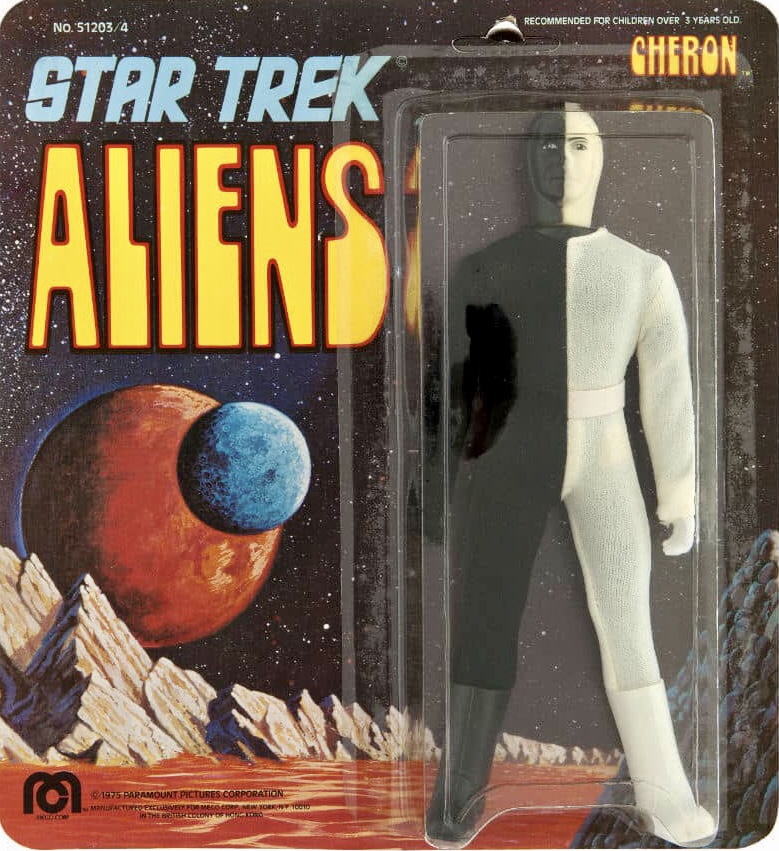
Market Value:
Carded $225 – $300
Loose $60 – $85
Cheron
Accessories: Cloth Jumpsuit, Black Boot, White Boot
Years Released: 1975
Difficulty To Find: Less Common – Appears less often
Notes: Of the four figures in this series, Cheron is the most true to the actual character from the television show. The Cheron figure is based on the character portrayed by Frank Gorshin on the show. The split colors actually make for a pretty cool look for the figure. It should be noted that the white half of the suit has a tendency to look pretty awful on loose figures due to a natural staining.
Gorn (The)
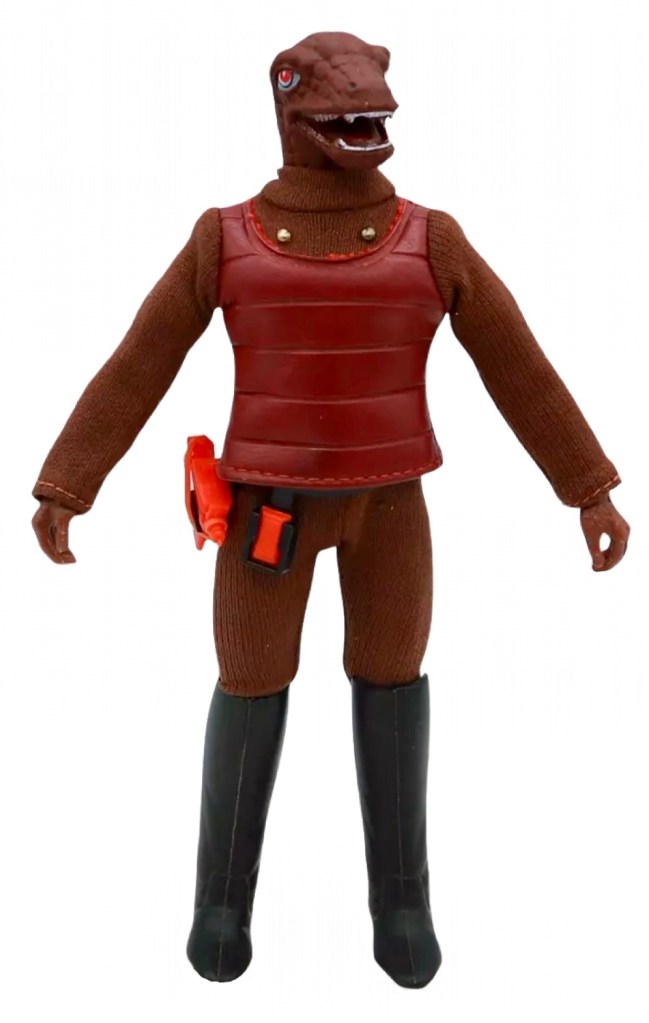

Market Value:
Carded $250 – $350
Loose $75 – $100
Gorn (The)
Accessories: Cloth Tunic, Pants, Boots, Belt, Phaser, Communicator
Years Released: 1975
Difficulty To Find: Moderate Difficulty – Not common
Notes: The Gorn was a case where Mego seriously dropped the ball. He was one of the most iconic Aliens from the Star Trek television show, but Mego used a re-painted head from the Lizard figure and the same outfit as the Klingon, complete with weapons belt, phaser and communicator. This figure does not resemble the classic character from the show at all, not even in the least bit, which was a rare miss for Mego.
Keeper (The)


Market Value:
Carded $225 – $300
Loose $60 – $85
Keeper (The)
Accessories: Cloth Robe
Years Released: 1975
Difficulty To Find: Less Common – Appears less often
Notes: The Keeper is another weird choice for Mego because the figure is kind of a combo of two different characters. The actual Keeper name was used as a title for the Talosian character in the Pilot episode, the Cage, but the appearance is modeled after a character that appeared on the screen from the Corbomite Maneuver episode. This figure literally came with one accessory, his robe.
Neptunian


Market Value:
Carded $300 – $400
Loose $85 – $115
Neptunian
Accessories: Cloth Jumpsuit, Webbed Boots, Webbed Gloves
Years Released: 1975
Difficulty To Find: Moderate Difficulty – Not common
Notes: Neptunian is a bit of an anomaly because the character never actually appeared in either the classic or animated Star Trek shows, but is still a beautiful figure. The boots and gloves are solely unique to this figure and had never been used before. Also, the head sculpt is really well done for an original figure and makes for an overall beautiful figure.
Star Trek (1976): Series 3 Aliens Figures
After great success with the first wave of Alien action figures released in 1975, Mego decided to released a 2nd wave of Aliens for their Series 3 of the Star Trek line. These figures were all based on characters from the classic television show.
Andorian


Market Value:
Carded $1,000 – $1,400
Loose $200 – $300
Andorian
Accessories: Cloth Bodysuit, Vest, Belt, Boots, Gloves
Years Released: 1976
Difficulty To Find: Hard to Find – Occasionally listed
Notes: Like the Romulan, the Andorian figure really captures the actual character from the show with a truly beautiful head sculpt, probably among the nicest that Mego had done for this line. The Andorian comes with a Super Knights like bodysuit and a brown vest with belt to complete the outfit. Like the other figures in this series, it is a very rare piece and considered bit of Holy Grail item for Star Trek Mego collectors.
Mugato

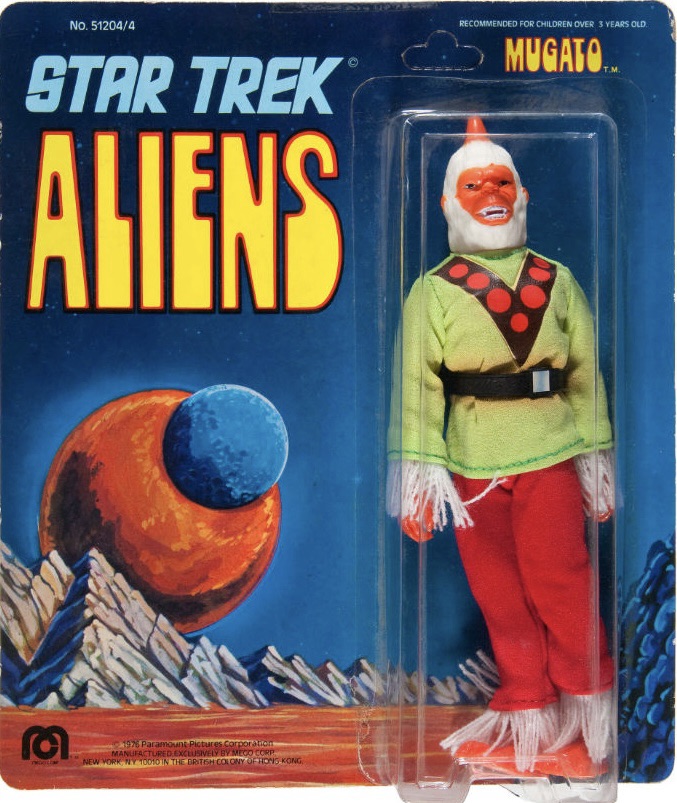
Market Value:
Carded $750 – $950
Loose $250 – $350
Mugato
Accessories: Cloth Shirt, Pants, Belt
Years Released: 1976
Difficulty To Find: Hard to Find – Occasionally listed
Notes: The Mugato was actually a creature featured in one of the classic Star Trek television episodes, but he was a beast from the wilds, and certainly not wearing any kind of clothes. The head sculpt actually does resemble the creature itself. There is a color variation to Mugato’s shirt with it being either a darker or light green. Like the other figures in this series, it is a very rare piece and hard to find.
Romulan
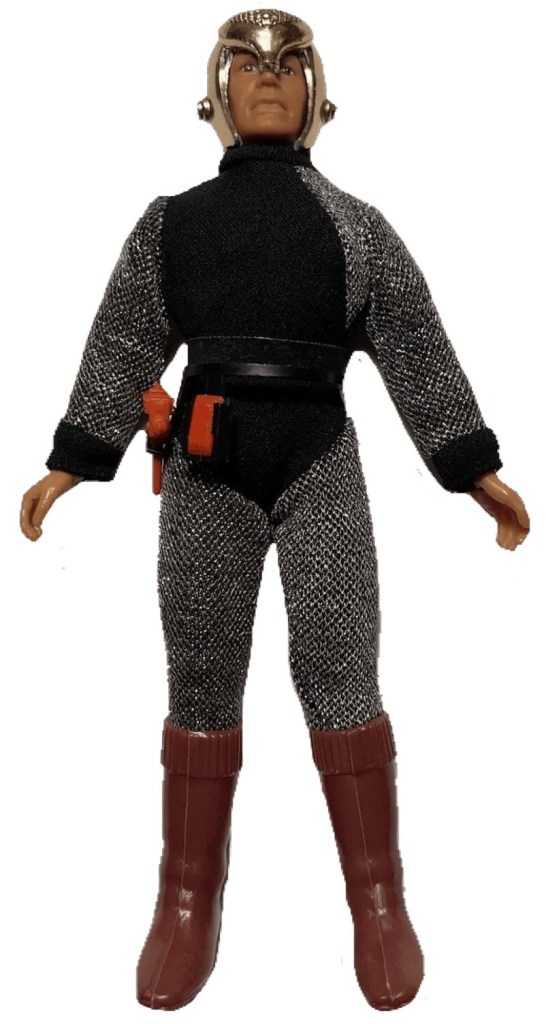

Market Value:
Carded $1.300 – $1,800
Loose $400 – $500
Romulan
Accessories: Cloth Bodysuit, Boots, Helmet, Belt, Phaser, Communicator
Years Released: 1976
Difficulty To Find: Rare – Rarely seen in any condition
Notes: The Romulan figure is largely considered among the holy grail items from Mego’s Star Trek line. The figure is based off the Romulan Commander character in the show portrayed by Mark Lenard with a really great head sculpt. This is a very attractive figure with a unique Super Knights looking bodysuit but what really stands out is that beautiful helmet! Like the other figures in this series, it is a very rare piece and hard to find.
Talos


Market Value:
Carded $750 – $950
Loose $250 – $350
Talos
Accessories: Cloth Jumpsuit, Belt, Boots
Years Released: 1976
Difficulty To Find: Hard to Find – Occasionally listed
Notes: Here is the other part of the Keeper figure, because this character should’ve actually been named the Keeper because that is what he was called in the episode. Instead Mego elected to call him Talos due to the planet he was from, but technically, it should’ve been Talosian. Still, the head sculpt is quite nice and this is a very rare figure for Star Trek and Mego collectors.
Star Trek (1974-1977): Accessories
There were several accessories released by Mego for their Star Trek line, but none were specifically made for the action figure series. Mego took advantage of their Star Trek toy license by producing several different types of products for their line.
Communicators
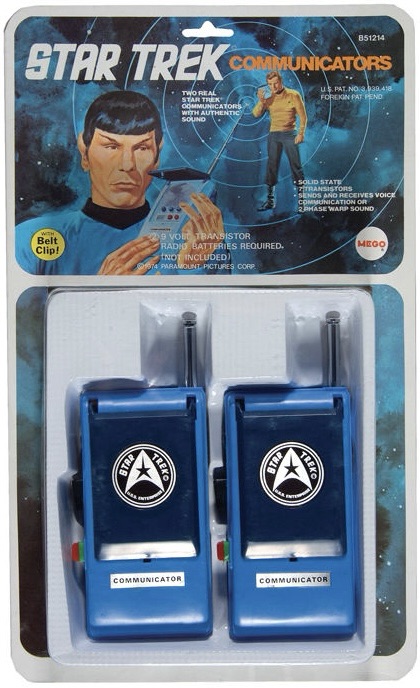
Market Value:
Boxed $200 – $275
Loose $40 – $65
Communicators
Accessories: Walkie Talkies x 2 w/ Flip Cover and Antenna
Years Released: 1974
Difficulty To Find: Moderate Difficulty – Not common
Notes: The Communicators set was the first accessory released by Mego for their Star Trek line in 1974. They were actual working walkie talkies that ran off 9V batteries. These were really great looking pieces and Mego did an excellent job of making them look like actual Communicators.
Command Communications Console

Market Value:
Boxed $225 – $300
Loose $50 – $75
Command Communications Console
Accessories: Communication Console w/ Light up Screen
Years Released: 1977
Difficulty To Find: Moderate Difficulty – Not common
Notes: The Command Communications Console actually worked in conjunction with the Communicators and would act as sort of a base station for communicating with them. Once again, Mego did a really great job of making the console look as if it belongs in the Star Trek universe.
Super Phaser II Target Game

Market Value:
Boxed $60 – $85
Loose $20 – $30
Super Phaser II Target Game
Accessories: Phaser, Target w/ Reflector
Years Released: 1976
Difficulty To Find: Common – Easily found
Notes: The Super Phaser II Target Game was basically Laser Tag before Laser Tag was Laser Tag. The premise was simple enough. It required you to set up the target, which was a portrait of a Klingon ship with a red reflector on it. Then, you would shoot the phaser at the reflector to register hits. It was a simple but fun game.
Telescreen Console

Market Value:
Boxed $400 – $500
Loose $125 – $200
Telescreen Console
Accessories: Game Screen and Console, Figure Chair
Years Released: 1977
Difficulty To Find: Hard to Find – Occasionally listed
Notes: The Telescreen Console was essentially a 1970’s style shooter game that was so primitive, it didn’t even keep score. The really cool thing about this set was it acted as part game and part playset due to the Console resembling a Enterprise Bridge computer with one of the chairs attached to it.
Tricorder

Market Value:
Boxed $275 – $375
Loose $100 – $140
Tricorder
Accessories: Tape Recorder w/ Flip Feature, Strap
Years Released: 1976
Difficulty To Find: Hard to Find – Occasionally listed
Notes: Since Mego had already released the Communicators, it only made sense that a Tricorder would be made. This was an actual tape player/recorder that was made to look like a Tricorder, complete with flip-out screen and all. Overall, this was a pretty cool thing to have strapped around your chest, just like the crew of the Enterprise.
Trekulator
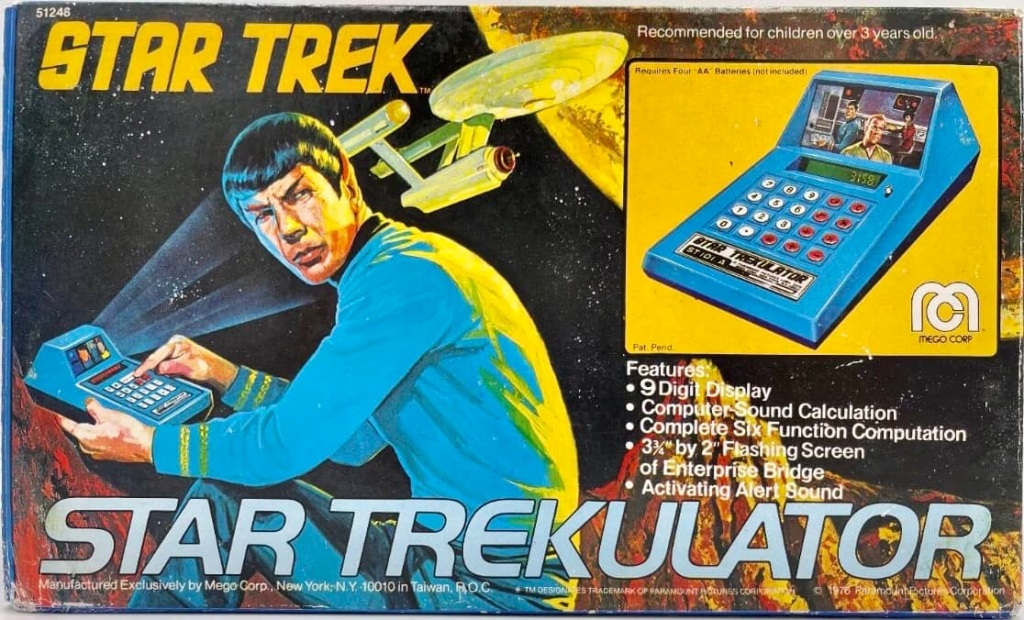
Market Value:
Boxed $500 – $700
Loose $200 – $250
Trekulator
Accessories: Calculator
Years Released: 1976
Difficulty To Find: Hard to Find – Occasionally listed
Notes: Who wouldn’t want a Star Trek Calculator back in 1976? I never knew about this back in the day, but if I had, I would’ve been bugging my mom to get me one. The calculator was designed to look like a science officer type computer that Spock might use on the show. It’s actually a tough item to find in boxed condition.
Star Trek (1974-1977): Playsets
Mego released two large scale playsets for their 8″ Star Trek line, with the U.S.S. Enterprise and Mission to Gamma VI playsets. A gift set version of the U.S.S. Enterprise was also released, along with a UK released Transporter Room accessory.
U.S.S. Enterprise Action Playset

Market Value:
Boxed $200 – $300
Loose $50 – $75

Gift Set Market Value:
Boxed $1,500 – $2,000
Loose $125 – $200

U.S.S. Enterprise Action Playset
Accessories: Plastic Fold-Out Playset, Captain’s Chair, Navigational Console, Stools x 2, Spinning Transporter
Years Released: 1974, 1975, 1976
Difficulty To Find: Less Common – Appears often but some hunting needed
Notes: The U.S.S Enterprise Action playset was the first released for the Star Trek line in 1974, and would go on to become one of most iconic large scale playsets that Mego ever created for their 8 Inch figures. The playset itself was not incredibly accurate to the actual bridge from the Enterprise, but it definitely captured the spirit of it, and it was just plain fun. It included a computer console with two crew member stools and of course, a captain’s chair. The coolest part of the playset was the transporter room. A figure was placed inside the transporter, and then spin it by using the buttons on top. Then you mash the stop button and the figure would disappear…..….or at least be on the other side of the transporter. This set sold extremely well and usually can be found on the secondary market for a reasonable price.
U.S.S Enterprise Action Gift Set – Mego bundled the U.S.S Enterprise Action playset with the remaining overstock of Series 1 figures (minus Uhura) and released it as the U.S.S. Enterprise Action Gift Set in 1977. It was essentially the same exact playset as the basic Enterprise release, but with the five figures (Kirk, Spock, McCoy, Scotty, Klingon) added. The figures themselves came inside individual clear bags and again, were the same Type 1 body figures as the basic issue. This is an extremely rare piece from Mego’s Star Trek line and can command BIG dollars on the secondary market if you are able to locate one in box.
Mission To Gamma VI Playset


Market Value:
Boxed $1,000 – $1,400
Loose $550 – $650
Mission To Gamma VI Playset
Accessories: Plastic Playset, Stairs, Trap Door, Cloth Glove, Trap Plant, Cardboard Floor and Cavern Pieces, Aliens x 4
Years Released: 1976
Difficulty To Find: Hard to Find – Occasionally listed and usually sells quickly
Notes: The Mission to Gamma VI playset was partially based on the Star Trek episode, “The Apple”. In that episode, there is a serpent looking head with glowing eyes and yes, there are man-eating plants and a subterranean cavern system too, so that was definitely the basis for this playset. All the décor and other features were all inspired from that as well. The miniature aliens were a new addition though because they never appeared in the episode. All of that being said, this is a strange playset for the 8 Inch figures. There is a rumor that a 3.75 Inch Star Trek line was planned and this playset was part of that, but the figures never actually made it to market and the playset was converted to the 8 Inch figures. I’m, not sure if that is true or not, but it does actually explain quite a bit. This is a tough find on the secondary market and can command top dollar if you can find a boxed version.
Transporter Room


Market Value:
Boxed $600 – $800
Loose $100 – $150
Transporter Room
Accessories: Spinning Transporter
Years Released: 1976
Difficulty To Find: Rare – Rarely seen in any condition on the secondary market
Notes: The USS Enterprise Playset was extremely popular and sold very well everywhere. The coolest thing about the playset, without a doubt, was the spinning Transporter Room. This got the attention of the Mego foreign brand company, Palitoy, who was their toy distributor in the UK and Canada. Palitoy took this super popular feature from the Enterprise and made it into a solo accessory simply called, The Transporter Room. It was basically the same spinning transporter from the bigger playset, except now it was by itself with no other pieces. The foreign released Transporter was also made famous by a 2012 episode of the Big Bang Theory, when Sheldon Cooper got one as a Christmas gift from Penny. I’m not sure how much Penny paid for the one she got, but these things are pretty rare and can fetch top dollar on the secondary market.
Star Trek (1974-1977): Vehicles
No actual vehicles were released for the Star Trek 8 Inch line during its run. A Vulcan Explorer motorized vehicle was actually proposed, but sadly never made it to market.
By 1974, Mego Toys was quickly becoming a global name in the toy industry. With the World’s Greatest Heroes line already proving to be a huge success, Mego turned their sights on other licenses from the the big and small screens with Planet of the Apes and now Star Trek, which were both released in 1974. The original Star Trek television series ran from 1966 to 1969 and spanned 79 episodes. In late 1969, Star Trek began running old episodes in syndication in over 200 markets, which sparked a revival of interest in the show from old and new fans alike. This renewed interest took off like wildfire and even spawned the first ever Star Trek Convention in June of 1972. Star Trek became so big, the original actors returned to voice their characters in the Animated Series from 1973 to 1974. Paramount’s strategy to syndicate Star Trek was paying off big time and the country was thrust into Trekkie mania. Mego took notice of this and quickly signed a licensing deal for a Star Trek toy line, for an extremely reasonable price. Mego had high hopes for the line from the very beginning, and put a lot of attention to detail into Star Trek, which really showed with the first series of figures and accessories released in 1974. Since Star Trek Mania was at a fevered pitch, the Star Trek action figure line turned out to be one of the biggest selling lines that Mego ever produced. It did well enough that a second and even third series of figures were released in following years. Star Trek Merchandise exploded into every retail store in the country, and even across the world, but none of them ever achieved the success that Mego did with their iconic toy line.
During its four year run, Mego gave us some truly iconic and classic figures and accessories for the Star Trek line from 1974-1977. In total, Mego released 14 different figures across three waves during its run, along with some great accessories and playsets. The first series initially contained five figures that included Captain Kirk, Mr. Spock, Dr. McCoy, Mr. Scott, and the Klingon. Lt. Uhura was added to the Series 1 lineup late, but she is still considered part of Series 1. The fact that Mego chose to release a female character (that traditionally did not sell as well to the target audience) over more well known characters, such as Sulu or Chekov was a bold but progressive move for Mego. Also released as part of Series 1 was the U.S.S Enterprise Playset and the Communicators set. The figures proved to be so popular that a second series was released in 1975, which was added four new Aliens characters to the set. Included in Series 2 were Cheron, The Keeper, Neptunian, and The Gorn. Four additional Alien characters were released in Series 3, which contained Talos, Mugato, Andorian and The Romulan. The last series of Aliens were released late, and are among the hardest to find Mego figures ever produced. Several other accessories and playsets were also released during Mego’s Star Trek action figure run, such as the Tricorder, Super Phaser II Target Game, Command Communications Console, and the Mission to Gamma VI playset. These all made for a lot of great fun, playing with the Star Trek action figure line, and remains beloved by that generation of children, myself included.
The packaging for the basic assortment of the Star Trek figures were colorful and extremely eye catching with beautiful artwork, which would remain a staple with Mego’s figure packaging. The Series 1 packaging in 1974 had each figure on a standard carded blister pack with the figure to the right side and a small beautifully drawn portrait of each character in the series to the left. The classic Star Trek logo was at the top of the left side of the card with each character’s name just above the blister bubble. The color of the character’s lettering varies, depending on which wave it was released in. Beginning in 1975 with Series 2, Mego changed the look of the cards to reflect the new Alien figures that were released in series 2 and 3. The Aliens cards featured a nice looking planet surface landscape with two planets or moons above it. Also, the word “Aliens” is placed below the Star Trek logo in huge yellow letters. All alien figures featured the same card as well with only the backs slightly different from Series 2 to series 3. All in all, the regular issue and Alien issue packaging was very attractive for the figures and even the sets and accessories were nice looking. Mego really did a good job with the Star Trek line and it paid off big time for them.

Series 1 Card Back

Series 2 Card Back
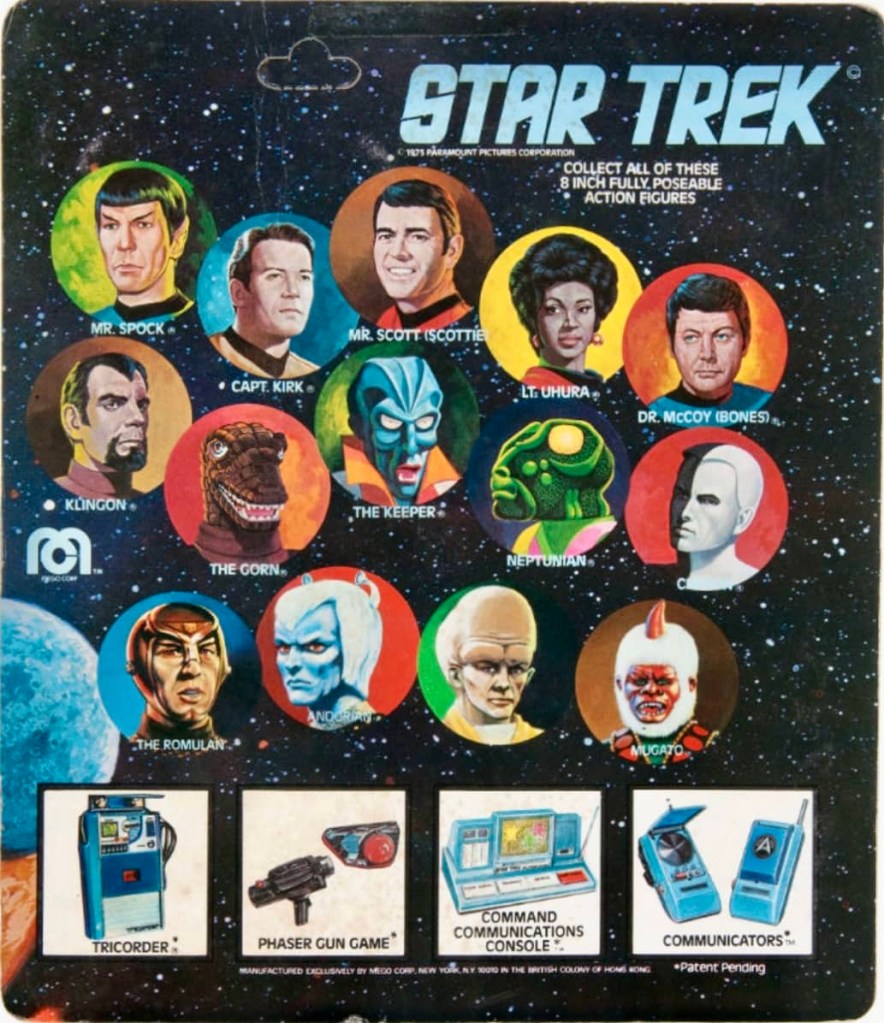
Series 3 Card Back






You must be logged in to post a comment.